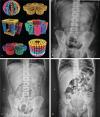Management of magnetic foreign body ingestion in children
- PMID: 33466161
- PMCID: PMC7808496
- DOI: 10.1097/MD.0000000000024055
Management of magnetic foreign body ingestion in children
Abstract
Magnetic foreign bodies ingestion is a special cause for attending emergency department. Here, we aim to analyze the characteristics and treatments of children who ingested magnetic foreign bodies (Buckyballs). Data were collected from children who ingested Buckyballs between February 2017 and October 2019. A retrospective analysis was performed to summarize the experiences of conservative treatment, gastroscopy and surgery when dealing with Buckyballs ingestion.A total of 49 patients with buckyballs ingestion were identified, of whom 11 underwent conservative treatments, 6 underwent gastroscopy, and 32 underwent surgery. Among such individuals, eight patients (72.7%) had a successful conservative treatment (number of Buckyballs [NB]: 3.5[IQR: 2.0-4.0]); four patients (66.7%) had Buckyballs successfully removed by gastroscopy (NB: 3.5[IQR: 3.0-5.5]); 16 asymptomatic (50%) patients (NB: 4.0[IQR: 3.0-8.0]) and 16 symptomatic (50%) patients (NB: 8.5 [IQR: 6.25-11.75]) received emergency surgery. Compared to patients who received conservative treatment, the number of ingested Buckyballs was significantly higher in patients who received surgery or gastroscopy (7.0 [IQR: 3.0-10.75] vs 3.5 [IQR: 2.0-4.0], P < .05). The risk of intestinal perforation was significantly higher in symptomatic patients (P < .05) compared to asymptomatic patients.Gastroscopy is recommended when Buckyballs are in the stomach or esophagus. In asymptomatic patients, conservative treatment can be considered for 4 to 6 days. Patients failing conservative treatment, or those who are symptomatic should undergo emergency surgery.
Copyright © 2021 the Author(s). Published by Wolters Kluwer Health, Inc.
Conflict of interest statement
The authors have no conflicts of interest to disclose.
Figures




References
-
- Ikenberry SO, Jue TL, Anderson MA, et al. . Management of ingested foreign bodies and food impactions. Gastrointest Endosc 2011;73:1085–91. - PubMed
-
- Arana A, Hauser B, Hachimi-Idrissi S, et al. . Management of ingested foreign bodies in childhood and review of the literature. Eur J Pediatr 2001;160:468–72. - PubMed
-
- Strickland M, Rosenfield D, Fecteau A. Magnetic foreign body injuries: a large pediatric hospital experience. J Pediatr 2014;165:332–5. - PubMed
-
- Waters AM, Teitelbaum DH, Thorne V, et al. . Surgical management and morbidity of pediatric magnet ingestions. J Surg Res 2015;199:137–40. - PubMed
-
- Nui A, Hirama T, Katsuramaki T, et al. . An intestinal volvulus caused by multiple magnet ingestion: an unexpected risk in children. J Pediatr Surg 2005;40:e9–11. - PubMed
Publication types
MeSH terms
LinkOut - more resources
Full Text Sources
Other Literature Sources
Medical

